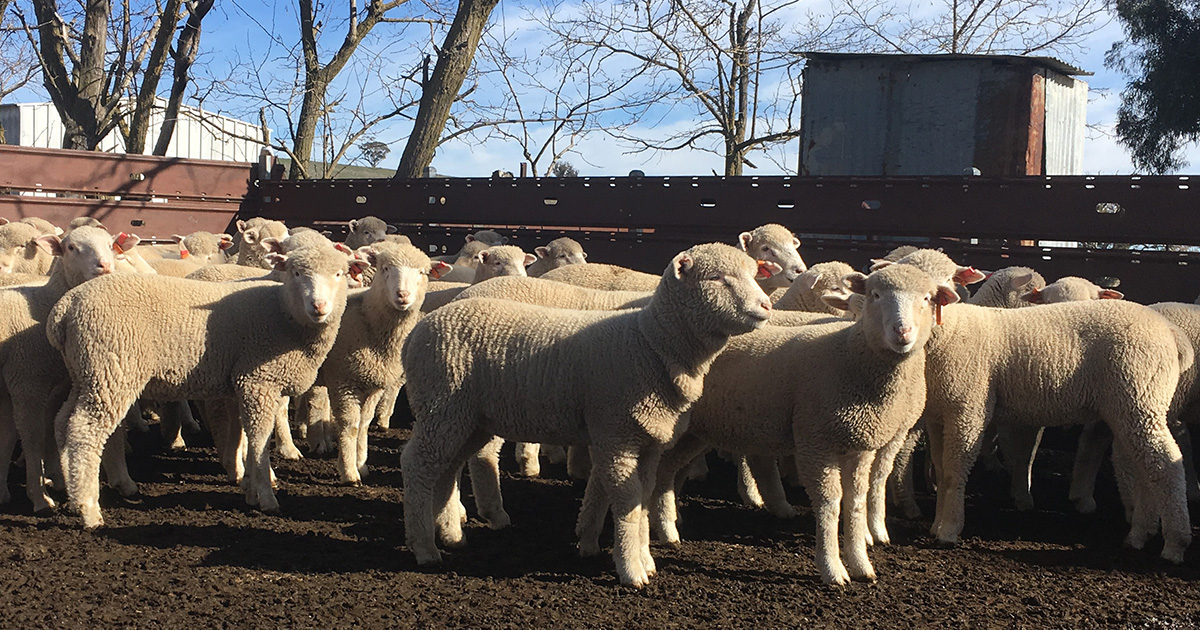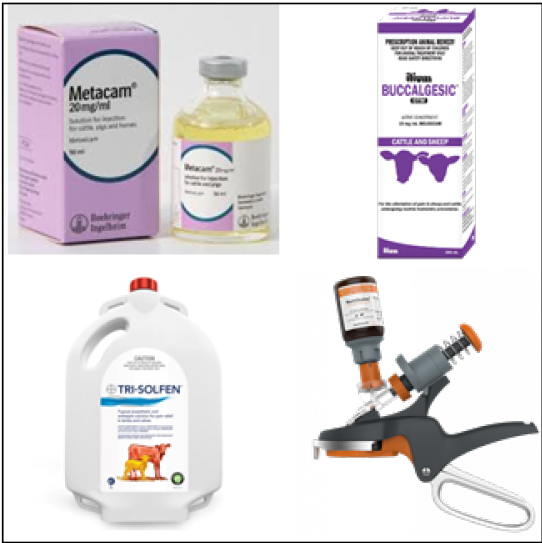Lamb Marking
Lamb marking refers to the procedures of tail docking, castration of males, ear marking, ear tagging, vaccination, and drenching.
Lamb marking is important in setting up the health of the animal and, if done poorly, has the potential to result in disease outbreaks.
Best practice lamb marking
The three fundamentals for best practice lamb marking are:
- Good hygiene
- Minimise stress
- Maximise recovery rate.
Lamb marking should be conducted efficiently to reduce the time the lambs are separated from their mothers, while allowing enough time for good technique. Lambs should be returned to the mothers as soon as possible to re-mother. Limiting the time the ewes are in the yards and off feed will also reduce the risk of the ewes being affected by hypocalcaemia. However it is always handy to have a few bags of 4 in 1 flowpack with you at lamb marking so you can treat any ewes that go down in the yards or on the way to/from the yards.
Age for lamb marking
Lambs should be marked between 2-12 weeks of age. This can be difficult to achieve in a mob that has an extended lambing period, and two marking sessions may be necessary. Lambs must be over 24 hours old to ensure a strong maternal bond has formed. Lambs over 6 months require anaesthetic for mulesing and castration.
Hygiene at lamb marking
Poor hygiene at lamb marking and mulesing can allow bacteria to enter through open wounds. This can cause diseases such as arthritis or Mycoplasma ovis, a potentially fatal bacterial infection of the blood which causes anaemia. Ensuring good hygiene during lamb marking is important to reduce the risk of infection post marking.
There are a few simple steps you can take to maximise hygiene during lamb marking including:
- Avoid yarding in muddy/wet or humid/dusty conditions. Avoiding muddy yards will also reduce the risk of foot abscess in your ewes.
- Soak instruments in disinfectant at the start of the day, clean between each animal and disinfect at frequent intervals.
- Thoroughly wash and disinfect hands at frequent intervals.
- Regularly change needles.
- Follow the label directions for diluting the disinfectant and replace the solution regularly if it is contaminated with blood or dirt – remember if the disinfection liquid is discoloured then the disinfection cannot work!
- Mark in temporary yards on clean ground or use a system where the lambs can be tipped out of the cradle straight onto their feet where they can walk away.
- Topical pain relief products that also contain antimicrobials, such as Tri-solfen, can help reduce the risk of bacterial infection of wounds as well as providing pain relief. Using any pain relief options will also help prevents lambs from dragging themselves across the ground in pain, therefore reducing the risk of wound contamination.

Vaccination options
Vaccination should be done using the right technique, the correct site and the appropriate needle size. Clostridial vaccines and Gudair should be given under the skin (sub-cutaneously) on the side of the neck, with the ¼ inch needle at a 45 degree angle.
If given too deeply, the inflammation caused by the vaccine will cause muscle damage that needs to be trimmed and Gudair if given too closely to the spinal vertebrae can result in ‘Gudair staggers’ – a syndrome caused by the inflammation site impacting the spinal cord.
Some of the most common vaccinations include:
- Clostridial vaccination: 5in1 or 6in1 are key in preventing some of the most commonly seen diseases in sheep – black disease, black leg, malignant oedema, pulpy kidney, tetanus +/- cheesy gland depending on if you choose to vaccinate with 6in1. With a promising Spring ahead with lush good quality feed on offer, Clostridial vaccines will be pulling their weight. The first primer dose should be administered at marking and then the booster 4-6 weeks later (typically at weaning). The second dose is important in establishing a robust immune response that is primed and ready to respond to clostridial diseases. In lambs on challenging feed (for example lucerne), it is recommended that a booster is provided every 3 months.
- Scabigard: Scabigard is a live vaccine providing protection against scabby mouth (Orf virus) that is scratched onto the skin under the forelimb. Orf virus is excellent at surviving for long periods in the environment, so once on a property it tends to remain. If you have orf present, it is recommended that you vaccinate to prevent uncontrolled outbreaks.
- Gudair: Gudair is the only registered vaccine for Ovine Johnes disease. Gudair should be administered to all breeding stock to be retained (ewe lambs & rams), and all wethers that are to retained for 2 years or more. As a mineral based vaccine, correct placement of the vaccine is important in reducing unwanted side effects from the inflammatory response.
- Erysipelas vaccination: There are multiple vaccines available on the market that provide protection from erysipelas – a common bacterial cause of arthritis. Glanery is a combined vaccine including protection from both clostridials as well as erysipelas. If erysipelas is causing arthritis in your lambs post marking, it can be an excellent tool with fantastic results. It is important to establish if erysipelas is the cause of arthritis, as there are many different causes of bacterial arthritis. Vaccinating for erysipelas will only assist if erysipelas is the causative agent in your flock. Diagnosing the cause of arthritis on farm is easy to do with your vet. Once confirmed on farm, the schedule of vaccination will depend on when outbreaks of erysipelas arthritis are typically seen in your flock.
Drenching
The seasonal conditions this year have resulted in many properties having higher than usual larval contamination of pastures. This has resulted in our District Vets seeing what is usually an uncommon scenario of lambs at foot having high worm egg counts prior to, or around the time of lamb marking.
Utilise worm egg counts to establish what the worm burden is in both the ewes and in the lambs (if 8 weeks or older) pre-marking. Based on your worm egg counts and property history, discuss with your vet if your lambs need a drench and if so, what the best drench would be to use.
Drench choice is important, not only so an effective product is chosen, but also so that the risk of toxicity from overdose is reduced.
Some producers have opted to manage ewes at pre-lambing with long-acting drenches but it is important to remember that the lambs at foot have still been exposed if pasture contamination was high.
Pain relief for lamb marking
 There are many options for pain relief at marking. The addition of even just one method of pain relief is better than none. The choice of product can be based on what would work in with your marking system, for example to give an injection of meloxicam under the skin is often an easy addition to the process.
There are many options for pain relief at marking. The addition of even just one method of pain relief is better than none. The choice of product can be based on what would work in with your marking system, for example to give an injection of meloxicam under the skin is often an easy addition to the process.
Different products target different pain receptors, and so utilising more than one product (multi-modal pain relief) is always more effective.
Best-practice lamb marking would be to give both a systemic anti-inflammatory and local anaesthetic. Ideally a combination of a product containing short acting pain relief provided by lignocaine would be combined with the long-acting pain relief of meloxicam.
You need to consider how that additional step, for example giving meloxicam, would fit into your lamb-marking process. The benefits of pain relief, in addition to the quicker recovery time, is likely to extend to consumer demand and welfare requirements. In Victoria, since 1 July 2020, it is a legal requirement to provide pain relief to sheep undergoing mulesing. At the end of the day, if you can reduce the level of pain experienced by an individual animal you are providing the best care for your animals.
Product | Active | Route of administration | When is it useful? | Duration of pain relief? | Where do you purchase? |
|---|---|---|---|---|---|
Tri-Solfen | Lignocaine (local anaesthetic), Bupivicaine (longer acting pain relief), Adrenaline (to reduce bleeding & prolong anaesthetic action) & Cetrimide (antiseptic) | Spray on wound | On open wounds (e.g. mulesing or surgical tail docking wound) | 24 hours | Local ag retailer |
Buccalgesic | Meloxicam | Oral gel administered between the molar teeth & cheek. | Long acting anti-inflammatory & pain relief. | Approx. 3 days | Veterinarian |
Metacam20 or Meloxicam20 | Meloxicam | Injection under the skin. | Long acting anti-inflammatory & pain relief. | Approx. 3 days | Veterinarian |
Numnuts | Lignocaine | Using the Numnuts applicator, when the ring is applied lignocaine is injected into the scrotum or tail. | When using rings. | Approx. 45 minutes | Veterinarian |
Lignocaine | Lignocaine | Injected into the spermatic cords & scrotum. | When castrating. Use should be discussed with your vet (risk of overdose if mis-used). | Approx. 45 - 1 hour | Veterinarian |
Tips for sheep health at lamb marking
This 20 minute webinar gives the key steps to ensure the best outcomes for your lamb mob, with the aim to maximise survival to weaning and long term production goals. It covers best practice lamb marking techniques to reduce pain, infection and longer term animal health issues in relation to tail docking and castration as well as vaccination.
Adapted from content by district vets Katelyn Braine, Linda Searle, and Mark Corrigan.